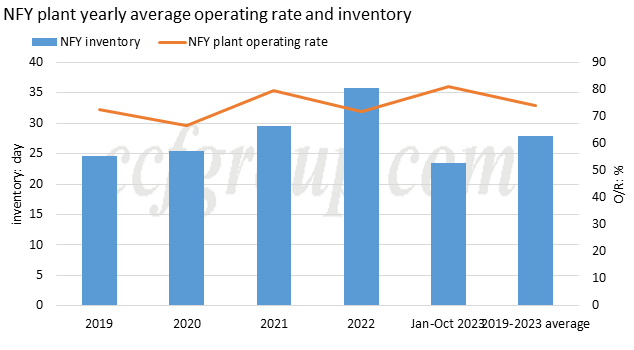How long could nylon textile filament demand last?
Entering November, nylon 6 textile filament demand is gradually weakening. However, it's more accurate to say that the peak season for nylon filament is not very pronounced rather than saying that it has been passing.
Unlike the period of March and April, when multiple products were in short supply and large number of back orders were reserved, the fluctuation in NFY demand in the second half of the year has been quite narrow. Demand for nylon textile filament could be described as "steady".

The steady situation is shown in that it has neither a best-selling product nor any clear weaknesses, in that the sales was not weak during the off-season or overly busy during the peak season, in that the products with high demand do not have high enough profits, while the products with slightly worse demand do not have significant losses. The overall operation of the nylon filament factory is in a very "healthy" state.
Since March 2023, only the short period in late August and H1 September saw less order taking and inventory accumulation, the rest of time basically saw a high operating rate and low inventory status of NFY plants. Even in the traditional off-season from June to July, the factory's orders did not show any significant decline, which is completely different from the same period in previous years. The annual average operating rate this year is the highest level in nearly five years, and the inventory is the lowest level in five years. Demand in previous years has rarely been in such a sustained and stable state. As the traditional peak season is near an end, how long can the stable situation of nylon filament last? In view of this, there are several issues worth paying attention to:
1. The off-season is not weak, and it is not all supported by rigid demand
When the early summer consumption season approached, demand for sun-screen-related products that surged in March and April cooled slightly. But the end users had extended the sun-screen products to many related products, which shifted demand for dull FDY 70D/48F to porous 40-70D, semi-dull/dull DTY, and those products had become a major support for higher-grade NFY in May-May.
Autumn and winter products are still the same old styles, and the market has no new growth point. The excellent performance of sun-screen-related products in the first half of this year has prompted some weaving factories to deploy the expected demand for next year's spring and summer from the end of August to early September. Because the start time was early, when prices of raw material fluctuated significantly from September to October, fabric factories in Guangdong remained calm, and their purchasing pace did not actively follow up due to the bottoming-out of NFY price. This was the main reason for a mild performance in the traditional peak season.
2. High temperature and tight funds of downstream mills
Because sun protection products were stored earlier, some downstream mills' funds gradually became tight since the second half of this year. In addition, after the hottest September ever recorded, October also saw the second-highest temperature in history. Some areas in China even exceeded the highest temperature in late October. Exceptionally warm weather is not only in China, with evidence of global warming, which also means that winter clothing consumption will be affected and the pressure on downstream funding will increase in the future.
3. New spinning capacity is increasing
The good demand in the early period also boosted the acceleration of filament capacity expansion. In the fourth quarter, despite the gradual weakening of demand, there will still be an additional capacity of more than 100,000 tons/year. This also means that some specifications that were previously tight will gradually ease or even be regionally loose.
In November, there are signs of seasonal weakness in the demand for nylon filament. But part of the demand for next year's spring and summer products has been already overdrafted in this autumn, and the pressure of downstream funds was rising, with their production intention and purchasing activities be limited at the same time. This also conforms to the current decline in large circular knitting and warp knitting mills' operating rate in Guangdong.
Before the end of the year, there are still many new production capacities for nylon filament waiting to be put into production. It is expected that there will be almost no opportunity for demand to explode before the end of the year, and the supply and demand relationship of nylon filament will gradually transition from tightness to balance or even looseness with regard to some specifications.
- Top keywords
- Cotton Price
- Cotton Futures Price
- Cotton Futures
- CZCE
- PTA Futures Price
- Chemical Fiber
- Polyester Prices
- Wool price
- PTA Futures
- Shengze Silk
- China
- Yarn Price
- price
- China Textile City
- Fibre Price
- Benzene Price
- Cotton
- Index
- Cotton Index
- PTA
- fabric price
- NYMEX
- Top 10
- textile industry
- Spot Cotton
- Cotton Yarn
- Polyester Price
- Futures
- PTA Price
- cotton yarn price

